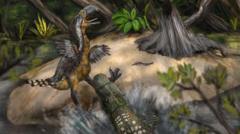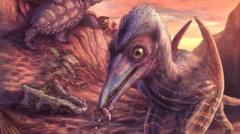In a groundbreaking study published in Biology Letters, researchers have provided compelling evidence of a dramatic clash between a terror bird and a formidable caiman dating back 13 million years. These avian giants, known for their fierce predatory skills, were potentially overwhelmed by an even larger reptilian threat, underscoring the complexities of prehistoric ecosystems.
Fossilized leg bones from a terror bird, excavated from Colombia's Tatacoa Desert, bear distinctive teeth marks reminiscent of a caiman, a crocodile-like predator. The meticulous analysis included 3D digital scans which revealed details of the attack, suggesting that the encounter was fatal for the bird.
The terror bird, reaching heights of 2.5m, was a significant predator of its time, employing its powerful legs and sharp beak to seize prey in wetland habitats. However, the findings raise questions about its survival against the caiman, identified as Purussaurus neivensis—a formidable species that could grow up to five meters long and ambush prey effectively from waterside.
Lead researcher Andres Link from Universidad de Los Andes commented on the implications of the findings, noting the absence of healing in the bite marks, which hints at a lethal interaction rather than mere scavenging. “If it wasn't already dead, it died in the attack," Link stated, reinforcing the notion that the encounter could have led to the extinction of this particular terror bird.
The fossil, originally discovered over 15 years ago, has provided a rare glimpse into an ancient world where apex predators fiercely competed for survival. This case underscores how each fossil reveals critical aspects of life on Earth during the Middle Miocene epoch, a time when the humid swampland of Colombia was rich with diverse species.
As scientists continue to piece together the fragments of life from the past, such discoveries reshape our understanding of ancient predator dynamics, suggesting that even the most dominant creatures had their vulnerabilities. The collaboration with local fossil collector César Augusto Perdomo is a testament to the community's effort to uncover and understand the historical significance of these fossils.
Overall, this study not only chronicles a violent struggle between two massive predators but also enriches our understanding of the ecological intricacies that existed millions of years ago.
















